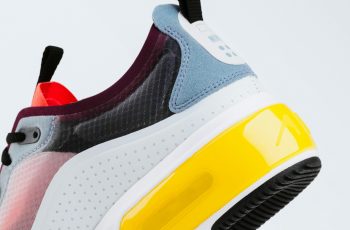In this article, you will discover the fascinating world of the sole structure in running shoes. As a runner, understanding the technical aspects behind the design and composition of your shoes is crucial to your performance and overall comfort. The sole is the foundation of any running shoe, providing cushioning, support, and traction. By unraveling the secrets of the sole structure, you will gain insight into how to choose the perfect pair of running shoes tailored to your individual needs. So, lace up, and let’s delve into the realm of running shoe soles!
1. Importance of Sole Structure in Running Shoes
When it comes to running shoes, the sole structure plays a crucial role in providing the necessary comfort and performance for your runs. The sole structure determines how the shoe interacts with the ground, affects your stability, and influences your overall running experience. Let’s explore the key reasons why the sole structure in running shoes is so important.
1.1 Provides Cushioning
One of the primary functions of the sole structure in running shoes is to provide cushioning. When you run, your feet endure a significant amount of impact force with each step. The sole structure, particularly the midsole, is responsible for absorbing this impact and preventing it from causing discomfort or injury to your feet and joints.
Different running shoe models incorporate various cushioning technologies to enhance shock absorption. Common midsole materials like EVA (Ethyl Vinyl Acetate), PU (Polyurethane), and TPU (Thermoplastic Polyurethane) are known for their ability to provide excellent cushioning properties. These materials, combined with innovative designs and technologies, deliver a responsive and comfortable running experience.
1.2 Offers Stability
Another essential aspect of the sole structure in running shoes is its ability to provide stability. When you run, maintaining proper balance and stability is crucial to prevent injuries and enhance your performance. The sole structure plays a significant role in achieving this stability.
Certain elements within the sole structure, such as the outsole and midsole, work together to provide stability during your runs. The outsole’s grip and traction patterns ensure a solid grip on various surfaces, preventing slips and falls. Additionally, the midsole’s design and materials contribute to stabilizing your foot, reducing the risk of ankle rolling or excessive pronation.
1.3 Facilitates Traction and Grip
Having good traction and grip is essential for any runner, regardless of the terrain they choose to run on. The sole structure in running shoes plays a significant role in facilitating traction and grip, helping you maintain control and prevent accidental slips.
Different types of sole structures are specifically designed for different running surfaces. For example, solid rubber soles are commonly found in road running shoes, offering excellent traction on pavement and other hard surfaces. On the other hand, trail running shoes often feature specialized trail-running soles, which are designed to provide enhanced grip on uneven, slippery, or muddy terrains.
2. Types of Sole Structures
Understanding the different types of sole structures used in running shoes can help you choose the right pair based on your running preferences and needs. Let’s take a closer look at some of the common sole structures you’ll come across in running shoes.
2.1 Solid Rubber Soles
Solid rubber soles are commonly found in road running shoes. They offer excellent durability and traction on hard surfaces like pavement and concrete. These soles provide a reliable grip, allowing you to maintain control and stability while running on urban terrains.
2.2 Carbon Rubber Soles
Carbon rubber soles are often used in running shoes designed for durability and increased mileage. They offer excellent traction and are resistant to wear and tear. These soles provide reliable grip on both road and trail surfaces, making them versatile for runners who enjoy different terrains.
2.3 Blown Rubber Soles
Blown rubber soles are known for their lightweight and flexible properties. They provide a comfortable and cushioned running experience, absorbing impact and reducing the strain on your feet. These soles are commonly found in long-distance running shoes, where comfort and resilience are paramount.
2.4 Trail-Running Soles
Trail-running soles are specifically designed to provide optimal grip and traction on uneven and challenging terrains. They feature aggressive outsole patterns with deep lugs, providing excellent stability and preventing slips on mud, rocks, and loose surfaces. If you enjoy running off-road or on trails, shoes with trail-running soles are the way to go.
2.5 Racing Soles
Racing soles are designed for ultimate speed and performance. These soles are incredibly lightweight and often minimalistic in design, allowing for maximum efficiency and fast-paced running. While they may lack extensive cushioning, racing soles are optimized to provide excellent traction and responsiveness, enhancing your speed during competitions or intense training sessions.

3. Understanding Midsole Technologies
The midsole is a crucial component of the sole structure in running shoes. It directly affects the cushioning, energy return, and support provided by the shoe. Understanding the different midsole technologies can help you select the most suitable running shoes for your needs.
3.1 EVA (Ethyl Vinyl Acetate)
EVA is a commonly used midsole material due to its lightweight and cushioning properties. It offers excellent shock absorption, protecting your feet and joints from the impact of running. EVA midsoles are comfortable and provide a responsive feel, allowing for a smooth and efficient running stride.
3.2 PU (Polyurethane)
PU midsoles are known for their durability and resilience. They provide excellent cushioning, making them ideal for long-distance runners or individuals seeking additional comfort. PU material offers enhanced stability and support, minimizing the risk of overpronation or other gait issues.
3.3 TPU (Thermoplastic Polyurethane)
TPU midsoles combine the best qualities of EVA and PU materials. They offer a balance of cushioning, responsiveness, stability, and durability. TPU midsoles are often found in high-performance running shoes, catering to runners who desire a well-rounded midsole with versatile characteristics.
3.4 TPE (Thermoplastic Elastomer)
TPE midsoles provide a blend of cushioning and responsiveness. They are known for their excellent shock absorption properties, ensuring a comfortable ride throughout your runs. TPE midsoles offer a good balance of flexibility and support, promoting a natural and efficient stride.
3.5 Gel Cushioning
Gel cushioning technology incorporates gel pods or inserts within the midsole to provide targeted cushioning and shock absorption. Gel-enhanced midsoles offer excellent comfort and impact protection, reducing the strain on your feet and joints. They are particularly beneficial for runners with specific areas of discomfort or high-impact zones.
3.6 Air Cushioning
Air cushioning technology utilizes air-filled chambers within the midsole to provide lightweight cushioning and responsiveness. These air pockets absorb shock and evenly distribute pressure, resulting in a comfortable and well-supported running experience. Air cushioning systems are often found in running shoes designed for long-distance running or individuals seeking maximum cushioning.
4. Analyzing Outsole Components
The outsole of a running shoe is the part that comes into direct contact with the ground. It plays a vital role in providing traction, flexibility, and durability. Let’s explore the different components of the outsole and their impact on your running performance.
4.1 Flex Grooves
Flex grooves are shallow indentations on the outsole that enhance flexibility and promote a natural range of motion. These grooves allow the shoe to bend and flex with your foot, mimicking the movement of barefoot running. More flex grooves translate to a more responsive and comfortable running experience.
4.2 Traction Patterns
Traction patterns on the outsole determine the shoe’s grip and ability to maintain traction on various surfaces. The design and arrangement of the grooves, lugs, and patterns play a crucial role in preventing slips and ensuring stability. Different types of running shoes may feature specific traction patterns tailored to the intended running surface, such as road running or trail running.
4.3 Durable Point of Contact
The outsole’s durability is essential, especially for runners who frequently log higher mileage. The point of contact that endures the most wear and tear is typically located at the heel and the forefoot. Durable outsole materials and reinforcements in these areas help prolong the shoe’s lifespan and maintain its performance over time.
4.4 Heel-To-Toe Drop
The heel-to-toe drop refers to the difference in height between the shoe’s heel and toe. It affects your running mechanics and the distribution of forces throughout your stride. Different running styles and preferences may require varying heel-to-toe drops. Traditional running shoes typically have a 10-12mm drop, while minimalist or zero-drop shoes have no significant height difference.

5. Considering the Insole Material
The insole of a running shoe is the layer located directly beneath your foot, providing additional cushioning, support, and comfort. Let’s examine the different insole materials commonly used in running shoes and their respective benefits.
5.1 Foam Insoles
Foam insoles are lightweight and offer excellent cushioning properties. They provide a soft and comfortable layer between your foot and the midsole, enhancing shock absorption and reducing pressure points. Foam insoles are versatile and suitable for most runners, delivering a balanced combination of support and comfort.
5.2 Ortholite Insoles
Ortholite insoles are made from a special open-cell foam material that provides enhanced breathability and moisture management. These insoles offer excellent cushioning and long-lasting comfort, making them ideal for runners seeking fresher and more hygienic running experiences. Ortholite insoles also help prevent the development of odor-causing bacteria, extending the life of your running shoes.
5.3 EVA Insoles
EVA insoles, similar to EVA midsoles, provide lightweight cushioning and responsiveness. They offer additional comfort and shock absorption, particularly in areas where the midsole may not provide sufficient support. EVA insoles are often removable, allowing runners to customize the fit and feel of their shoes by replacing them with aftermarket insoles if desired.
5.4 Gel Insoles
Gel insoles utilize gel cushioning technology to provide targeted support and comfort. These insoles contour to the shape of your feet, providing customized cushioning and reducing pressure points. Gel insoles are suitable for runners seeking maximum impact absorption and relief from foot discomfort or pain.
6. Weight and Sole Structure
The weight of a running shoe is an essential consideration for many runners. The sole structure directly affects the overall weight and can significantly impact your running experience. Let’s explore the different aspects of weight and sole structure in running shoes.
6.1 Lightweight Soles
Running shoes with lightweight soles are favored by runners aiming for speed, agility, and a more natural running experience. Lightweight soles reduce the overall weight of the shoe, allowing for faster foot turnover and minimal energy expenditure. These shoes are popular among sprinters, race enthusiasts, and runners seeking a more responsive and efficient stride.
6.2 Thick and Cushioned Soles
Thick and cushioned soles are ideal for runners seeking maximum shock absorption and plush comfort. The additional cushioning provided by these soles reduces stress on your joints and muscles, particularly during longer runs or for runners with specific comfort needs. However, it’s important to note that thicker soles may result in a slightly heavier shoe.
6.3 Balanced Approach
Finding the right balance between sole thickness and weight is crucial for many runners. Manufacturers continuously strive to develop innovative sole structures that offer a lightweight design without compromising on cushioning or stability. Strike a balance that suits your running style, preferences, and the specific demands of your training or races.

7. Specialized Sole Structures
Not all runners have the same gait, foot mechanics, or running goals. Therefore, specialized sole structures have been developed to cater to specific needs or conditions. Let’s explore some of these specialized sole structures commonly found in running shoes.
7.1 Motion Control Soles
Motion control soles are designed to provide stability and support for runners who overpronate excessively. These soles feature firmer materials and supportive structures aimed at correcting the inward rolling motion of the foot during the gait cycle. Motion control shoes are suitable for runners with flat feet or a heavy overpronation tendency, helping them achieve a more neutral foot position.
7.2 Stability Control Soles
Stability control soles cater to runners who mildly overpronate or require additional support and guidance. These soles offer a balance between cushioning and stability, helping prevent excessive foot motion and maintaining a more natural gait. Stability control shoes are suitable for runners with a mild to moderate overpronation tendency or those seeking additional support during their runs.
7.3 Neutral Soles
Neutral soles are designed for runners with a neutral foot strike and minimal overpronation. These soles focus on providing cushioning and flexibility without built-in support structures. Neutral shoes offer a versatile option for runners who require minimal guidance or prefer a more natural running experience. They are often lightweight and suitable for various running distances and paces.
7.4 Performance Enhancing Soles
Performance enhancing soles are aimed at runners seeking to maximize their speed, efficiency, and race performance. These soles often incorporate advanced technologies and materials to provide exceptional energy return, responsiveness, and ground contact feel. Performance enhancing shoes are usually lightweight and engineered to optimize running economy and stride efficiency.
8. Impact of Sole Structure on Running Efficiency
The sole structure of your running shoes can significantly impact your running efficiency and overall performance. Let’s explore how different elements of the sole structure influence various aspects of running efficiency.
8.1 Energy Return
Energy return refers to the shoe’s ability to convert the energy absorbed during foot strike into forward propulsion. The midsole materials and technologies used in the sole structure play a crucial role in determining energy return levels. Responsive and resilient midsole materials, such as EVA foam or TPU compounds, can enhance energy return, allowing you to push off the ground more efficiently with each stride.
8.2 Shock Absorption
Shock absorption is essential in preventing fatigue and decreasing the risk of injuries during your runs. The sole structure, particularly the midsole and insole materials, help absorb and dissipate the impact forces generated when your feet strike the ground. Adequate shock absorption reduces the stress on your joints and muscles, providing a more comfortable and less fatiguing running experience.
8.3 Pronation Control
The sole structure in running shoes can influence pronation control, which is the way your feet roll inward or outward during the running gait cycle. Different types of sole structures are designed to provide varying degrees of support and guidance for runners with different pronation patterns. The right level of pronation control can help align your feet, reducing the risk of injuries and promoting a more efficient stride.
8.4 Toe-Off Efficiency
Toe-off efficiency refers to how effectively your foot pushes off the ground during the propulsion phase of your stride. The sole structure affects your ability to generate power and propel forward. Shoes with responsive midsole materials and outsole design features, such as flex grooves, optimize toe-off efficiency, helping you maintain a smooth and efficient running stride.
9. Considering Different Running Surfaces
The sole structure of your running shoes should be tailored to suit the type of running surfaces you typically encounter. Different terrains demand varying levels of traction, durability, and stability. Let’s explore the various running surfaces and the corresponding sole structures that optimize your performance.
9.1 Road Running Soles
For road running, choosing running shoes with solid rubber soles is ideal. Solid rubber soles offer excellent grip on hard surfaces like pavement and concrete, providing reliable traction and stability. These soles are designed to withstand the wear and tear associated with road running, ensuring long-lasting performance.
9.2 Trail Running Soles
Trail running requires specialized sole structures that can handle the challenges of uneven, slippery, or muddy terrains. Shoes with dedicated trail-running soles featuring aggressive outsole patterns and deep lugs provide the necessary traction and grip. These soles excel in maintaining stability and preventing slips, ensuring you can confidently conquer any trail.
9.3 Track Running Soles
Track running demands shoes with lightweight soles that allow for maximum speed and minimal energy loss. Racing soles, featuring minimalistic designs and optimal responsiveness, are often the preferred choice for track runners. These soles ensure a quick turnover and efficient stride on well-maintained, consistent surfaces.
10. Sole Structure and Foot Biomechanics
Understanding your foot biomechanics is essential when considering the sole structure in running shoes. Different foot types and specific needs require varying levels of support, stability, and cushioning. Let’s explore how the sole structure can address specific foot biomechanics.
10.1 Arch Support
Individuals with high arches typically require shoes with adequate arch support to maintain foot alignment and prevent excessive stress on the arch. Shoes with stability control soles or additional arch support technologies can help promote a more neutral foot position and prevent overpronation.
10.2 Heel Support
Those with a tendency for heel pain or instability can benefit from running shoes with reinforced heel support. A stable and strategically designed heel counter can help stabilize the foot and minimize excessive motion during the gait cycle. This support reduces the risk of injuries and enhances comfort for runners experiencing heel-related issues.
10.3 Toe Box Design
The design and fit of the toe box play a crucial role in addressing toe-related discomfort or conditions. Shoes with a roomy toe box allow adequate space for toe splay and accommodate foot deformities or conditions like bunions. The toe box design should provide comfort while maintaining proper fit and preventing friction or pressure points that could lead to blisters or pain.
In conclusion, the sole structure of running shoes is vital for ensuring comfort, performance, and injury prevention. By understanding the different aspects of sole structure, you can make informed decisions when selecting running shoes that best suit your running style, foot biomechanics, and preferred running surfaces. Whether you’re a seasoned runner or just getting started, finding the right sole structure can significantly enhance your running experience and help you achieve your goals.


